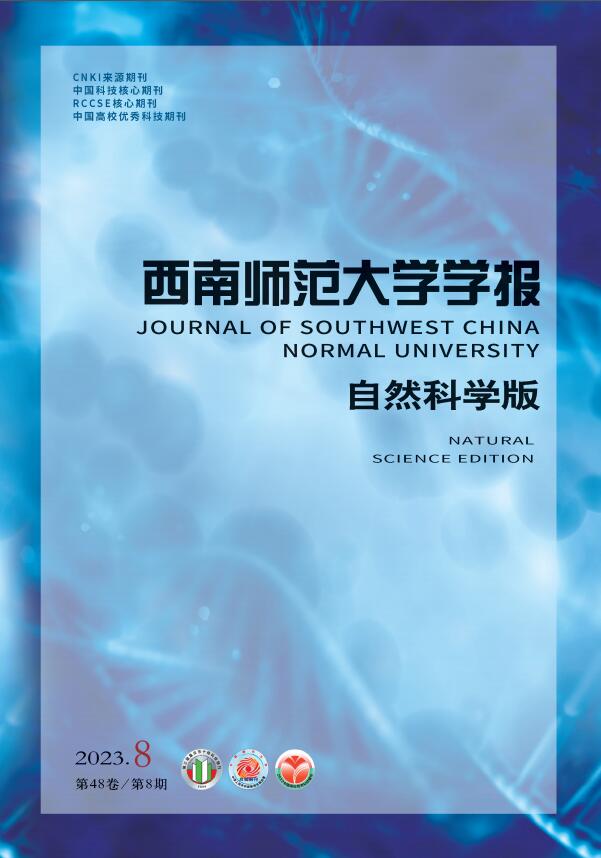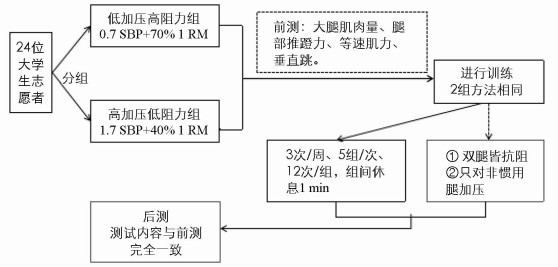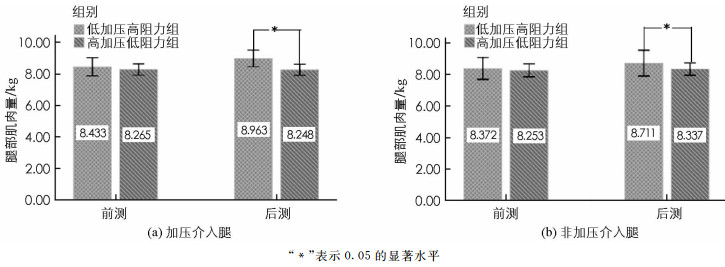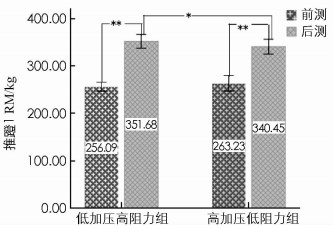-
适当进行抗阻力训练可预防骨质流失、提升功能性体能及增进运动表现[1-2].但要提升肌力或肌肉肥大,则需要用6~12 RM最大重复次数的训练量,训练强度至少超65% 1 RM[3-5];而加压训练(充气式压力约100~300 mmHg,绑住运动肢段近端)只需采用较低负荷(20%~50% 1 RM)则可达到预期目标[6-7].超65% 1 RM的阻力负荷属于中高强度,对于已有运动伤害的运动员、肌力减弱的老年人或长期卧床的病患而言显然是不适合的,但倘若阻力运动强度过低,则又无法对肌肉造成有效刺激.加压抗阻力训练最低仅需使用20% 1 RM的强度,就能明显改善肌肉适能[8],并于此强度下进行阻力训练,所需消耗的能量与日常生活中的身体活动量相当[9],故加压训练在运动训练及保健康复领域越来越受到重视.
加压训练作为一种替代性训练方式,其独特性是加压介入能达到维持肌横断面积及肌力的效果,其中“加压+低强度抗阻”训练能起到增大肌肉量的目的[10-11].从早期研究文献中发现[12-13],当Ⅰ型肌纤维被招募而处于疲劳状态,Ⅱ型肌纤维被招募的时间就会提早,而当加压训练造成肢段缺血,相关代谢压力增加而造成疲劳的状态时,可以招募更多Ⅱ型肌纤维的运动单位,且当介入20% 1 RM的训练强度时,肌肉招募情形相当于日常生活10%~30%的最大运动量[14]. Jahyun Kim等[15]让受试者用拐杖行动30天,使单侧下肢悬挂(简称ULLS)于无负重状况,实验组采用“ULLS+加压运动”,每周3次,压力为1.3 SBP,强度为最大自主收缩力的20%,结果发现膝关节伸展运动后,实验组肌横断面积及肌力仅有稍微下降(分别下降1.2%及2.0%),而控制组(ULLS)的膝伸肌力及跖屈肌则皆显著下降(分别对应下降7.4%及21%),且实验组膝伸肌肌耐力增进31%,而控制组则下降24%. Bird等[11]将优秀运动员随机分为“低强度+加压组”(简称LIO,50% 1 RM+200 mmHg)、“低强度组”(LI,50%1RM)及控制组(CON),8周训练结果后发现LIO组的肌横断面积、肌力、及肌耐力皆呈显著提升;而关于手术后重建研究发现[10],接受前十字韧带术后,实验组进行大腿近端加压(平均压力238 mmHg)处理(2次/天、5组/次、5 min/组、组间休息3 min),而控制组则没有加压处理,结果发现手术后14天实验组与控制组的肌肉横断面积显著降低,实验组与控制组的膝伸肌横断面积分别降低9.4%及20.7%,膝屈肌横断面积则分别降低9.2%及11.3%,且实验组的膝伸肌下降情形显著低于控制组,从而肯定了加压刺激能有效减少术后膝伸肌横断面积的萎缩. Danny Christiansen等[16]让实验组在跑步机上进行3周“加压+走路”训练(6天/每周、2次/天、5组/次、2 min/组、组间休息1 min、行走速度50 m/min),控制组仅进行同样强度的走路运动,结果发现实验组的大腿肌肉横断面积及肌肉量增加4%~7%,且1 RM及最大等长肌力增加8%~10%,而控制组则没有变化. Keishoku Sakuraba等[17]将受试者分成低强度运动组(LI,20% 1 RM)与“低强度阻力+加压组”(LIO,20% 1 RM+200 mmHg),经连续6天、2次/天的训练,结果发现训练后LIO组股四头肌横断面积及肌肉量分别显著增加3.5%及3.0%,LI组则没有变化.
上述有关加压介入抗阻训练的硏究,绝大多数研究属于短期性干预,而长期训练是否对提升肌力或肌肉肥大有效未见有关报道.基于此目的,本研究将探讨低压高阻及高压低阻训练对腿部肌肉量所造成的影响,并进一步分析低压高阻及高压低阻训练对腿部推蹬、原地跳跃能力的影响,据此揭示加压抗阻力训练对改善肌肉适能的强度特征,从而为运动训练及保健康复领域如何科学运用加压介入手段提供参考.
HTML
-
先将受试者依年龄、身高、体质量、收缩压及舒张压等因素随机分配为2组,一组实施低加压高阻力,另一组实施高加压低阻力;同一组中的受试者又以惯用腿与非惯用腿作为对照,其中惯用腿实施“加压+抗阻”,而非惯用腿只实施“无加压+抗阻”.
-
试验于2018年5月至6月在天津体育学院人体科学实验大楼完成.
-
本研究以24名男性大学足球专选班学员为实验对象,将其随机分成低加压高阻力组(0.7SBP+70% 1 RM)及高加压低阻力组(1.7SBP+40% 1 RM).实验前经检测,2组受试者的年龄、身高、体质量、收缩压及舒张压差异不具有统计学意义(p>0.05).
入围标准:①受试者须接受体格检查,身体无外伤(或损伤);②出于自愿原则,且能努力完成本研究的阻力训练任务;③受试者先前皆无从事阻力运动习惯;④受试者未参与任何康复治疗,亦未服用过慢性病相关的药物.排除标准:①身体有外伤或损伤,且无法完成本研究的阻力训练者;②平时有规律从事阻力运动者;③服用过慢性病相关的药物.
-
1) 受试者首先了解本研究相关的测验内容、流程、风险及训练效果,之后填写同意书及健康状况调查表.在前测开始前1周对受试者统一讲解相关说明及动作要领;
2) 在训练开始前一周完成前测,前测内容包括血压、身体组成、等速肌力(1.04 rad/s和3.14 rad/s)、跳跃表现(原地摆臂垂直跳、跨步垂直跳)、大腿推蹬1 RM;
3) 前测完成后,分别对2组受试者进行8周加压抗阻力训练,受试者双腿皆进行大腿推蹬阻力训练,但仅对非惯用腿进行加压;
4) 运动训练8周后进行后测,测试内容与前测流程见图 1.
-
受试者首先进行热身活动,接着按不同阻力负荷将杠铃片放至大腿推蹬机上,在确定受试者腿部为放松状况下,将血压带(67.5 cm×14.2 cm)固定于加压腿(非惯用腿)近端,并使用手动气阀血压球及表式血压计控制加压压力;受试者的推蹬训练被要求膝关节屈曲时须达到90°,训练频率为3次/周、5组/次、12次/组、组间休息1 min,休息结束,加压带中的压力完全释放,受试者完全休息.低加压高阻力组及高加压低阻力组的加压压力及阻力负荷设置在参考先前研究成果[10, 17]基础上有所调整,平均加压压力及阻力分别为(89.4±9.05) mmHg及(200.5±12.6) mmHg,而平均阻力分别为(168.2±19.5) kg及(84.2±21.6) kg.
-
1) 腿部肌肉量的测量.利用体成分分析仪(Inbody 720,产地:韩国)进行检测.在8周正式训练前、训练后进行,测量受试者双腿腿部肌肉量,要求测量前3 h禁止饮食及剧烈运动,以排除对身体组成的影响.
2) 大腿推蹬1 RM测量.受试者先热身,并于其大腿推蹬机上准备1 RM测试,完成最初预估的个人阻力负荷后,休息2~3 min,依据受试者完成的次数,给予更高的阻力负荷.检测过程中受试者被要求膝关节屈曲达90°,若无法达到该角度,则该次测试视为失败,所有受试者皆于5次测试内完成个人1 RM检测.
3) 肌力测试.采用等速肌力测试系统(Biodex Inc.,Shirley,NY产地:美国)进行检测,在60°/s及180°/s 2种速度下进行伸膝与屈膝,获得膝关节屈伸力矩峰值.受试者坐于测试车上,下背部贴近椅背,在调整座椅深度后,将其躯干、髋关节及测试腿部加以固定,并将测量仪动力计的轴心对准膝关节旋转点(股骨外踝),完成关节活动范围设定及校正后,固定踝部位置即开始测试.测试前,受试者先以非最大努力膝部伸展、屈曲进行3次练习,在30 s休息后,再以最大努力膝部伸展、屈曲测试3次.每个受试者皆需要完成惯用腿及非惯用腿的测试,并记录其伸展及屈曲的最大力矩峰值(N·m).
4) 爆发力测试.采用光栅系统(Fusion Spor,SmartSped,产地:澳大利亚)进行跳跃表现测试.先进行原地摆臂垂直跳(counter movement jump,CMD).让受试者站立于测试垫旁,当光栅讯号亮起时,受试者踏上测试垫准备,双脚与肩同宽且双膝弯曲至适当角度,同时手臂上摆带动身体向上跳跃,滞空时,双腿必须保持一直线,着地时膝关节微弯以缓冲落地的冲击.每位受试者进行2次测验,取其跳跃高度最佳成绩,并记录跳跃高度(cm)及腾空时间(ms).
接着进行跨步摆臂垂直跳(strides jump,SJ).受试对象站立于测试垫外准备,当光栅讯号亮起,单脚向前跨岀一步且双脚同时落于测试垫内,接着膝关节弯曲,配合双臂带动身体向上跳跃,滞空时双腿必须伸直,落地时双脚微弯以减少地面造成的反作用力.每位受试者测2次,取跳跃高度较佳成绩,记录跳跃高度(cm)及腾空时间(ms).
-
运用统计分析软件SPSS 21.0对本研究所获相关运动学、动力学及生物化学等参数进行处理分析.统计方法为混合设计双因素方差分析,影响因素包括时间因素(干预前、干预后)及组别因素(低加压高阻力与高加压低阻力).所有统计指标的显著水平设定α=0.05.
1.1. 实验设计
1.2. 时间及地点
1.3. 实验对象
1.4. 研究设计
1.4.1. 实验流程
1.4.2. 加压抗阻方式
1.5. 相关指标测量
1.6. 数理统计法
-
表 1显示,2组受试者的年龄、身高、体质量、收缩压及舒张压差异皆无统计学意义(p>0.05).
-
同一组别间的比较发现(图 2):对于低加压高阻力组,加压介入腿与非加压介入腿前测值差异无统计学意义(p>0.05),但经过8周运动训练后,加压介入腿与非加压介入腿的后测值皆显著优于前测[(8.96±1.25) kg比(8.43±2.11) kg,p<0.05;(8.71±2.06) kg比(8.37±1.59) kg,p<0.05)],且加压介入腿与非加压介入腿后测结果显示,前者腿部肌肉量显著优于后者[(8.96±1.25) kg比(8.71±2.06) kg,p<0.05)];对于高加压低阻力组,加压介入腿与非加压介入腿腿部肌肉量的前测值及8周训练后测值差异皆无统计学意义(p>0.05).
图 3显示,无论是加压介入腿还是非加压介入腿,低加压高阻力组与高加压低阻力组前测腿部肌肉量差异无统计学意义(p>0.05),但经过8周运动训练后,皆一致表现为低加压高阻力组腿部肌肉量显著优于高加压低阻力组[(8.96±1.25) kg比(8.25±1.62) kg,p<0.05;(8.71±2.06) kg比(8.34±1.87) kg,p<0.05)];8周运动训练后,低加压高阻力组及高加压低阻力组间的加压介入腿及非介入腿的腿部肌肉量相比较,差异皆无统计学意义(p>0.05).
-
图 4显示,不同组别之间大腿推蹬1 RM差异无统计学意义(F=0.001,p>0.05),但不同测量时间(前、后测量,F=886.3,p<0.05)与组别之间交互作用(F=10.24,p<0.05)对大腿推蹬1 RM有显著影响.组内比较发现低加压高阻力组及高加压低阻力组的8周后测值皆显著优于前测[(351.68±71.21) kg比(256.09±45.25) kg,p<0.01;(340.45±70.83) kg比(263.63±58.14) kg,p<0.01)];组间比较显示8周后测低加压高阻力组大腿推蹬1 RM的表现显著优于高加压低阻力组[(351.68±71.21) kg比(340.45±70.83) kg,p<0.05)].
-
表 2显示:①低加压高阻力组中,当角速度处于1.04 rad/s时的伸膝动作中,加压腿与非加压腿前、后测膝伸力矩差异无统计学意义(p>0.05),而角速度处于1.04 rad/s时的屈膝动作中,只有加压腿后测值显著优于前测[(122.75±42.63)N·m比(104.55±31.54) N·m,p<0.05)];在角速度为3.14 rad/s时的伸膝动作中,只有非加压腿后测值显著优于前测[(140.05±35.36) N·m比(122.32±45.26) N·m,p<0.05)],在角速度是3.14 rad/s的屈膝动作中,只有加压腿后测值显著优于前测[(107.32±28.06) N·m比(91.56±29.58) N·m,p<0.05)]. ②高加压低阻力组中,不论角速度是1.04 rad/s的屈伸膝动作还是角速度1.04 rad/s的屈膝、伸膝动作,加压腿与非加压腿前、后测膝伸力矩与屈力矩皆一致表现为后测值显著优于前测值.
-
表 3显示:①不论是低加压高阻力组还是高加压低阻力组,原地摆臂垂直跳所获得的跳跃高度及腾空时间皆一致表现为8周后测值显著优于前测;从提升幅度看,高加压低阻力组在跳跃高度及腾空时间上的表现要优于低加压高阻力组(跳跃高度提升率为12.6%比8.5%;腾空时间提升率为8.7%比4.4%). ②不论是低加压高阻力组还是高加压低阻力组,跨步摆臂垂直跳所获得的跳跃高度及腾空时间同样一致表现为8周后测值显著优于前测;从提升幅度看,高加压低阻力组在跳跃高度及腾空时间上的表现要优于低加压高阻力组(跳跃高度提升率为16.8%比12.6%;腾空时间提升率为9.1%比5.7%).
2.1. 受试者基本信息
2.2. 加压阻力训练对腿部肌肉量的影响
2.3. 大腿推蹬1 RM表现分析
2.4. 膝关节屈伸肌力矩表现分析
2.5. 垂直跳运动表现分析
-
1) 加压介入抗阻力训练对腿部肌肉量的影响
Konsgaard等[6]研究发现,2周中、高加压结合低强度阻力训练(160~240 mmHg+20% 1 RM)可以显著增加肌横断面积,表现为股四头肌、股二头肌及臀大肌肌肉量分别显著增加约7.7%、10.1%及9.1%,而且蹲举与腿部屈曲1 RM分别增加9%及2%;与之相对应的未介入加压的低强度阻力组,其股四头肌及股二头肌肌肉量只分别增加1.4%及1.9%,且肌横断面积及臀大肌皆没有变化.与此研究发现相类似,Bird等[11]研究同样发现,与“纯抗阻力运动组”相比,“加压+抗阻力运动组”的肌横断面积显著增加.上述有关“加压+低阻力训练”的研究中,其训练时间皆在2周以内,肌肉量增加非常显著,这可能是由于每周所采用的训练频率较高,因此对腿部肌肉量的增加有显著效果.本研究采用低加压高阻力训练,其强度采纳ACSM(2009)关于增加肌肉肥大的强度推荐值,结果发现受试者腿部肌肉量呈显著改善;但高加压低阻力训练组腿部肌肉量没有显著增加,这可能是先前研究中多采用双腿皆介入加压,而本研究仅针对单腿进行加压,因而腿部肌肉量的增加情形受到限制,若本研究高加压低阻力训练中针对双腿同时加压,或许可以有效增加肌肉量,这需要未来进行深入探讨;此外,本研究还发现低加压高阻力组训练后肌肉量增加值显著优于高加压低阻力组,可见腿部肌肉量的增加很可能主要受高阻力运动强度的影响,而加压介入的影响作用则为次要的.
2) 加压介入抗阻力训练对腿部等速肌力的影响
本研究发现,低加压高阻力组的加压腿在角速度是1.04 rad/s及3.14 rad/s时,膝关节屈曲等速肌力皆有显著提升,且无加压介入腿在3.14 rad/s时,膝关节伸展肌力矩上亦有明显进步.说明平日进行低加压压力训练后,当进行膝关节等速肌力测试时,恰好是测试大腿推蹬,必须抵抗向下的阻力,故受过低加压压力训练过的大腿可能在膝屈曲上有较佳的表现;另外一种可能解释是,低加压高阻力训练中虽然阻力较高,但却仅有部分肌力呈显著增加,这可是因为8周的训练期,受试者有可能对这种高阻力(一般约70% 1 RM)强度产生了适应,且加压压力较低而无法有效达到交叉迁移的效果,因此肌力的提升表现受限.本研究中,高加压低阻力训练(1.7 SBP+40% 1 RM)后,在角速度是1.04 rad/s及3.14 rad/s时,伸膝与屈膝皆有显著的进步,这与先前的研究成果类似,这可能是高加压与神经交叉迁移有关联,故较高加压介入有益于增加肌力表现.据Marques等[18]研究显示,当身体的单侧进行阻力运动时,未训练的一侧也会因为交叉迁移现象而有所改善;Colomer等[19]指出,当单侧从事阻力训练使肌力增加35%时,未受训练的对侧肢段肌力也会增加7.8%.有文献[20-21]以上肢双侧手臂进行阻力运动,但仅对单侧进行加压,同样的无论是否进行加压,运动组双臂的二头肌屈肌与三头肌伸肌肌力、臂围及肌横断面积皆有显著进步,认为未加压手臂能达到显著的肌力增加,主要也是受到神经交叉迁移影响.本研究也是采用双侧阻力运动、单侧施予加压方式,尽管高加压低阻力组在训练后腿部肌肉量未有显著增加,但等速肌力的正面效果明显受高加压介入的影响,且本研究中低加压高阻力组在加压侧有较佳的肌力表现,故可认为加压训练对于肌力表现的增加具有较好的效果,而阻力训练的强度则可能对肌肉量的增加效果更佳.
3) 加压抗阻力训练对大腿推蹬1 RM的影响
关于加压抗阻训练对大腿推蹬1 RM的影响效应,Sumide等[22]研究发现,以20% 1 RM结合不同加压压力(50 mmHg,150 mmHg及250 mmHg)可显著提升角速度是1.04 rad/s的膝伸肌肌力,而无加压组没有进步;在角速度是3.14 rad/s的肌耐力测试中,结合各种加压的组别中等速肌力矩皆有显著进步,且角速度是3.14 rad/s的总量介入在50 mmHg及150 mmHg的组别中有显著增加. Oesen等[5]研究发现,加压阻力训练组(50% 1 RM+200 mmHg)在8周训练后,其等速肌力角速度是3.14 rad/s的肌耐力测试的表现有显著改善.本研究高加压设为1.7 SBP(平均压力约为201.4 mmHg),训练方式与肌力测试方式与Wu等[10]设计基本接近,结果发现高加压低阻力组及低加压高阻力组推蹬1 RM表现皆有显著进步,但低加压高阻力组的训练效果明显优于高加压低阻力组.
4) 加压介入抗阻力训练对垂直跳的影响
据Manimmanakorn等[8]研究报道,膝伸展及屈曲训练中结合加压(20% 1 RM+230 mmHg),被试5周后肌力、20 m折返跑、垂直跳的表现比单纯的伸展及屈曲训练(控制组)有明显进步;另有研究[23-24]显示,进行3周训练(3次/周、5组/次、反复次数5次),训练模式为“70% 1 RM抗阻+加压压力180 mmHg”,结果发现,训练后受试者胸推、深蹲、最快冲刺时间及原地摆臂垂直跳皆有显著进步.以上研究所呈现的跳跃表现结果皆与本研究基本类似,由于Cook等[25]研究的干预时间仅3周,其训练强度为较高强度(70% 1 RM)因而效果显著,而本研究中的原地摆臂垂直跳及跨步摆臂垂直跳在低加压高阻力及高加压低阻力训练后皆有显著进步.高加压低阻力训练后的腿部肌肉量没有明显增加,这可能与本研究采用的阻力为大腿推蹲训练有关,该动作与跳跃动作相似,故跳跃能力有明显提升.
-
1) 8周低加压高阻力训练能显著提升腿部肌肉量,且加压腿及无加压腿皆进步显著,腿部肌肉量的增进受到较高强度阻力训练的影响.
2) 低加压高阻力与高加压低阻力训练皆能显著提升大腿推蹬1 RM表现,但低加压高阻训练的等速肌力在加压腿膝屈曲方面有较好的表现,而高加压低阻训练在膝伸展及屈曲的表现上,无论是否为加压腿皆有显著进步.
3) 低加压高阻力与高加压低阻力训练皆能显著提升跳跃表现,但高加压低阻力组的提升效果要优于低加压高阻力组.
4) 若以训练效果而言,高加压低阻力训练以较低的阻力即可有效增进运动表现,并且对阻力运动初学者、运动损伤的运动员及肌力较弱的老年人而言,是一项较安全的选择;若以训练对肌肉量的影响而言,低加压高阻训练更有效,故从事训练初期,可先采用高加压低阻力训练,肌肉得到适应后,再介入高加压低阻力训练以增加肌肉量.










 DownLoad:
DownLoad: